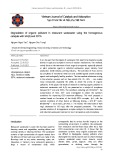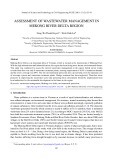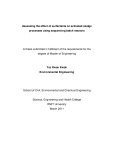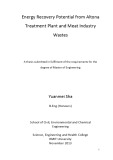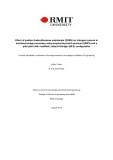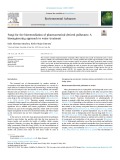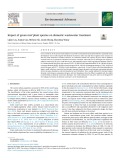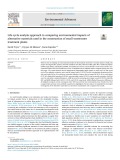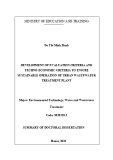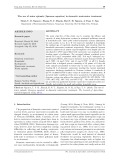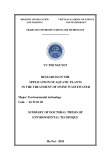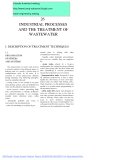
Wastewater treatment plants
-
It can be seen that the objects of wastewater that need to be treated are quite diverse in types and complex in terms of reaction mechanisms. The methods mainly focus on the treatment of toxic organic compounds, especially phenols or plant protection agents in industrial wastewater, paper industry, food production, textile industry, printing industry.
 6p
6p  vikwong
vikwong
 29-09-2024
29-09-2024
 4
4
 0
0
 Download
Download
-
This study was conducted to assess the current wastewater management in the region. Initial survey results revealed that there was only 8 wastewater treatment plants, meeting requirement of 6.9% of treatment demand, and the sewer coverage was 69%.
 10p
10p  vifilm
vifilm
 24-09-2024
24-09-2024
 3
3
 1
1
 Download
Download
-
Anionic and non-ionic surfactants have been detected in the influents to and effluents from wastewater treatment plants (WWTPs). Linear alkylbenzene sulphonates (LAS) and alkylphenol ethoxylates (APEO) are the most frequently detected anionic and non-ionic surfactants in urban wastewater. The aim of this study was to assess the effect of the presence of anionic and non-ionic surfactants in the influent to WWTPs on activated sludge processes.
 111p
111p  runthenight05
runthenight05
 01-03-2023
01-03-2023
 8
8
 3
3
 Download
Download
-
The aim of this project is to provide a summary of the current knowledge on energy recovery options from wastewater treatment plants sludge and/or biosolids. This covers technologies as well as data from case studies and research experimental results. The focus of the study is the ATP. The project methodology comprised two stages. The first stage involved a review of the current literature.
 166p
166p  runthenight07
runthenight07
 01-03-2023
01-03-2023
 7
7
 3
3
 Download
Download
-
Municipal wastewater treatment plants generally utilise biological activated sludge processes to remove organic compounds and nitrogen. The biological nitrogen removal (BNR) occurs in two steps, nitrification (ammonium removal) and denitrification (nitrates removal). This study focused on a medium-sized wastewater treatment plant (WTP) which experienced poor nitrification for years, mainly when the weather temperature drops.
 125p
125p  runthenight07
runthenight07
 01-03-2023
01-03-2023
 7
7
 3
3
 Download
Download
-
In this work, we review various PhCs detected in water treatment plants. We propose that fungi, particularly white-rot fungi (WRF), can be used for their bioremediation and describe the main mechanisms used for degrading this type of emerging pollutants; however, we also highlight the need to prospect for new fungal models.
 10p
10p  thebadguys
thebadguys
 15-01-2022
15-01-2022
 18
18
 4
4
 Download
Download
-
Water quality indicated by chemical oxygen demand, total nitrogen, ammonium nitrogen, and total phosphorus from the effluent complied with the widely accepted limits on domestic wastewater discharge. Our results demonstrate that green roofs can be designed for the ecological treatment of domestic wastewater on the household scale.
 10p
10p  thebadguys
thebadguys
 15-01-2022
15-01-2022
 9
9
 1
1
 Download
Download
-
The results showed that SS demonstrated substantially higher impact in total (5.47 Pt) and across each of the endpoint categories, most notably human health (3.12 Pt). Further investigations demonstrated that this was largely fed by the respiratory inorganics midpoint category that accounted for 50 % of the total impact (2.75 Pt).
 13p
13p  thebadguys
thebadguys
 15-01-2022
15-01-2022
 13
13
 0
0
 Download
Download
-
Design evaluation criteria for sustainable development of urban WWTPs; apply the evaluation criteria and techno-economic criteria to ensure the sustainable development of Bac Ninh WWTP.
 31p
31p  kequaidan7
kequaidan7
 01-09-2020
01-09-2020
 27
27
 4
4
 Download
Download
-
The main objective of this study was to examine the efficacy and capacity of using hydroponic systems in municipal pollutant removal at household scale. Three pilot scaled hydroponic systems [dimension for each system: 4.5 m (L) x Φ 114 mm] were installed to investigate the optimal age of vegetable, planting density and retention time for household wastewater treatment, respectively.
 6p
6p  tomhiddleston
tomhiddleston
 27-05-2020
27-05-2020
 35
35
 2
2
 Download
Download
-
This research was carried out to evaluate the effect of organic loading rate to the performance of anaerobic co-digestion digester treating organic fraction of food waste (FW) and sludge waste (SW) from wastewater treatment plant. The experiment was conducted in two runs: Run S50, substrate contained 50 % of FW and 50 % of SW in term of volatile solid (VS) concentration; Run S100 (control run) contained 100 % SW in the influent substrate.
 6p
6p  abcxyz123_02
abcxyz123_02
 03-03-2020
03-03-2020
 43
43
 2
2
 Download
Download
-
The objective of research is to build CNST using TVTS to treat pig waste water after microbiological treatment, to minimize environmental pollution. Technology is feasible when applied in practice.
 27p
27p  xacxuoc4321
xacxuoc4321
 11-07-2019
11-07-2019
 36
36
 3
3
 Download
Download
-
The organisation of sewers and systems is closely related to the different types of industry and, as a result, a whole array of configurations exist. In all cases, it is essential to avoid unnecessary dilution during treatment.
 91p
91p  real_spamer9x
real_spamer9x
 03-12-2012
03-12-2012
 89
89
 21
21
 Download
Download
-
MBR (Membrane Brio-Reactor) can be broadly defined as systems integrating biological degradation of waste products with membrane filtration. Set up of MBR plant is mainly utilizing a bioreactor and membrane filtration as one unit process for wastewater treatment thereby replacing, and in some cases supplementing, the solids separation function of secondary clarification and effluent filtration, resulting the possibility to eliminate the secondary clarification and operate at higher MLSS concentration....
 7p
7p  phuongltht
phuongltht
 06-04-2011
06-04-2011
 139
139
 34
34
 Download
Download
CHỦ ĐỀ BẠN MUỐN TÌM








